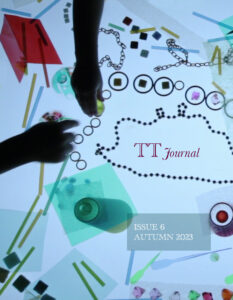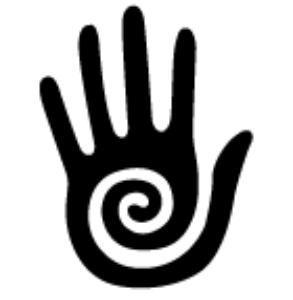Dear Reader
It’s the first week of September, children are back to school and I find myself editing a short video about my daughter’s playschool, which I have been working on sporadically, over the whole year, in an attempt to capture some of the school’s activities, in relation to the changing seasons. I have decided to make this film for many different reasons, not least because I am so impressed by the dedication, enthusiasm and creativity of the group of women running it and the wonderful benefits this brings to the children. At the same time, I have been thinking of the theme of play as something to be explored in more depth in this journal. Another impulse to consider the theme of ‘play’ came from remembering a short film at an exhibition called PLAY WELL, at the Wellcome Collection, London in 2019. The film, which I am delighted to share with you in this current issue of the journal, is about early years education in Pistoia, Italy. It captures beautifully, through image and word, the importance of providing children with the right conditions to feed their senses, in order to nourish their imagination and inner worlds. In this approach, an environment is considered as a playful collaborator, with whom new configurations and relationships are explored and created. Through their play, the children reconfigure elements of their environment, and for a moment, they are masters of their own world order.
One of the vital features of free play, whether in childhood or adulthood, is the opening of a space of receptivity, the welcoming of the as yet unformed, while suspending any expectations of what the outcome should be like. Simply finding joy in the experience of being. It is a place of an open-ended curiosity, of surprise, of flurry of activity and also stillness. In play, the unpredictable – the element of chance – is both embraced but also defied, through finding new structure, new dynamics, new configurations. Play reconciles these opposites: it takes control while also relinquishing it.
Elements of uncertainty, contingency and transformation are at the heart of not just play, but life itself. We are constantly navigating a life that is fundamentally unpredictable, ever changing and to a great extent out of our control. In order to stay in tune with this reality, we need the act of play to remind us what we once knew. Through play we are acknowledging the interconnectedness of things: The fact that we do not exist or create in a vacuum. Each action impacts our surroundings and these surroundings in turn impact us. Play, just as the creative process, is a form of tuning into the reality of this fundamental relationality and reciprocity inherent in the world, its aliveness and potential.
As children we understand that play is essential and sensory, we are not satisfied with sitting passively and imagining. We pick up a stone, a twig, we imagine but we also touch and smell, see and hear, half driven by some vague intention but equally open to the surprises the objects themselves reveal as they come to life, suddenly animate. As adults, engaged in a creative act, we start with an idea. We want to share this idea, and we know that it needs to be communicated and embodied in some way. It has to pass through a medium, it has to “materialise” in the world. It might become a written word, a clay shape, paint on paper, a gesture of the body, a sound produced by an instrument drifting through air. All these materials and tools, as well as the hands, mouths and bodies that produce them, are not just passive conduits or recipients. They too have a memory, experience, purpose, and thus shape the expression as it is being uttered. The mode of the output affects the thinking itself. In that process between the idea and its realisation much happens and some of it might be a surprise to us. The more factors there are involved in the idea’s emergence into the world, the richer the potential. In other words, there is a point to the process itself.
With the increase of technological presence in our lives, including the rise of AI technologies, the question of what it means to create or even simply “do” something is gaining a new significance. This is because the connection between our action and its impact is often and increasingly more so, obscured behind technological interface, which itself hides processes that have become incomprehensible to most of us. Actions have thus become conceptualised and our bodies little more redundant. Pressing a button or a screen, the same gesture, leads to many different outcomes. The indexical relationship between us as embodied beings and our environment is being weakened.
Companies and corporations try and smooth out the interface and iron out irregularities to offer an easy consumer experience. The process becomes hidden from us and our creative options are narrowed. The interface speaks back to us generically and receives ever more generic answers. So how do artists attempt to subvert this situation in order to reintroduce contingency, bring back the unexpected, bring back the sensing, feeling body? What does it mean to be productive and creative in the age of AI? What can play teach us about meaningful process, about being, co-existence, co-creation and collaboration, not only with fellow humans but also the larger environment which we are part of? Isn’t the extinction of variety of species which is happening in the external world, also happening to our inner worlds, precisely because the two are completely interwoven? As Ed Yong puts it in his wonderful book An Immense World, “Less diversity means one less opportunity for understanding the world, of making sense.” So how can we protect the endangered wild parts of our children’s imagination as an ecological project?
You may find some answers to the above questions in these digital pages, containing essays, personal reflections, articles, films and poems from our dear contributors. At a time when much of the education system and work life is being streamlined and focused on the final product and productivity, we are all delighted to celebrate here the beauty and joy of the seemingly futile, the apparently unnecessary, the seriously ludicrous, the unapologetically far-fetched, the deeply curious…Together we look for new patterns in the seemingly senseless chaos around us, making sense of nonsense. We ascribe objects new and unintended meanings and in the process of doing this we reinvent ourselves.
We play here because we rejoice in taking detours. This is because we believe that a long (and slow) way round can be more insightful than a shortcut and that sometimes it can also be a good idea to take the plunge without thinking much: To jump into a muddy puddle simply for the pleasure of hearing the splash and seeing what happens.
Tereza Stehlikova, 8th September 2023
Visit our content page to find out more:

Cover images: Bartolomeo Pampaloni
Many thanks to all the contributors for being part of the TT journal community.
Thank you to Rosalyn Driscoll for editorial help and Susan Hibberd for help with proof reading.
Thank you to Michal Klodner for ongoing help with this site, so generously hosted by https://node9.org/
